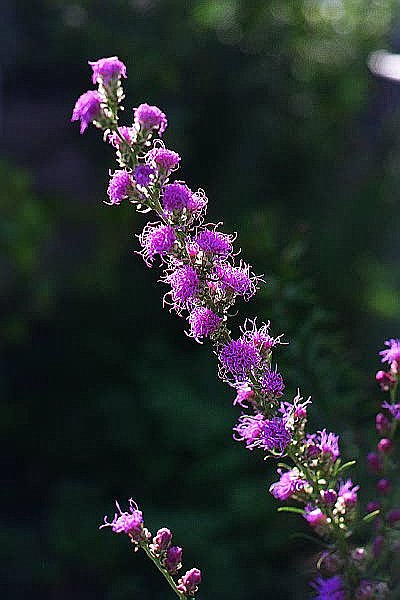


|
Rough blazing star is another native of the prairies. Its found from North Dakota to Ohio and south. It is typically found in poor, rocky, often acidic soil where there is little other vegetation. Thompson and Morgan rate their well-bred variety for zones 5 to 9 while other blazing stars are rated for colder conditions. This well-bred variety is also taller than the wild plants. |
Almost every liatris you can get will be liatris spicata and it will be bred to grow 1.5 to 3 feet tall, too short if you ask me since I've seen them in our forest preserves reaching up to 6 feet tall. Thompson and Morgan rated L. aspera at 4-6 feet so I had to give it a try. They grew very slowly the first year. Maybe part of the problem was that they were first started in Park's Starts cylinders before being placed in the ground. There is very little nutrition to be found in one of these cylinders unless you constantly give them a weak solution of fertilizer water, which I didn't do because I thought they would grow roots into the soil and they didn't. They form small bulbs (really corms) making them easy to move around in the spring or fall. Plant them with the top of the root at or very near the surface. They do not bloom the first year.
All the pictures I've ever seen show a single unbranched column at the top of the plant but one plant has produced branches at the top of the plant with a number of buds on each branch. All of them are bending over rather than standing straight up so some support may be desirable. The record so far is 4.5 feet tall, not yet the 6 feet I was hoping for.
One nice feature of this species is that blooms later in the season, in late August to September after L. spicata. Another feature is that you get blooms over about 3 feet of stem on a 4.5 foot plant, this compares with about 1.5 feet of bloom on a 3 foot L. spicata. Of course the flowers are not as densely packed as L. spicata. Butterflys like the flowers and goldfinches will eat some seeds.
They can get mildew so arrange for them to be in a sunny location where there is good air circulation. They can also rot so keep some seeds on hand or let the plants go to seed. They are supposed to be native to rocky, dry soil so the next test I plan to run is to put them in sandy soil in a very hot, dry location.